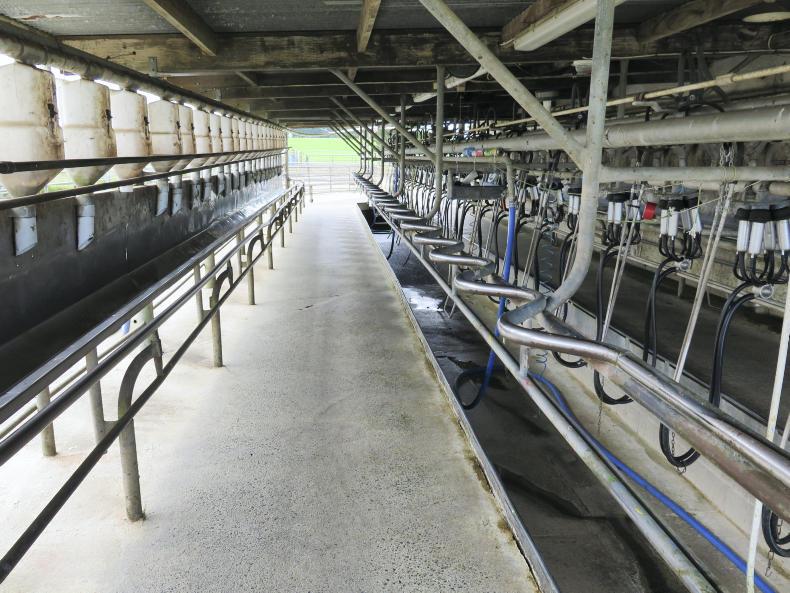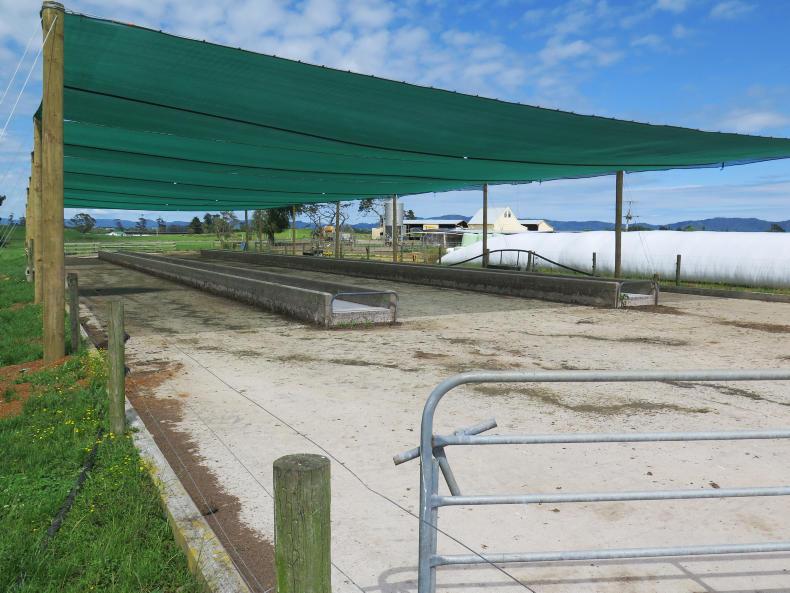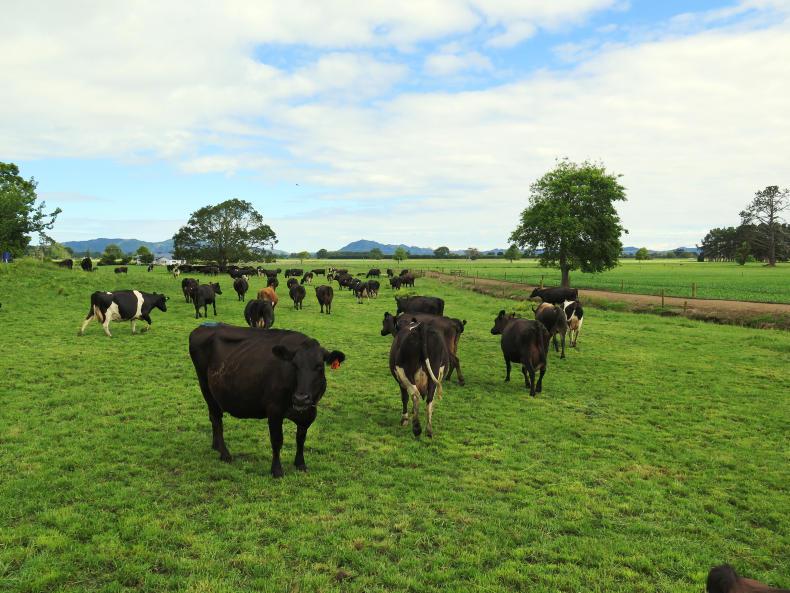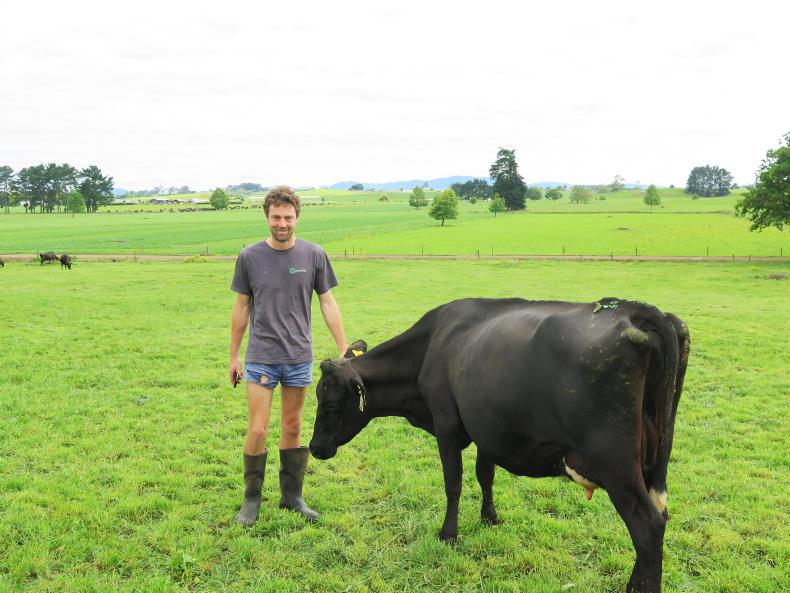Jamie Haultain spent the first eight years after college working for Dairy NZ as a scientist and then as a consulting officer. Dairy NZ is the Teagasc equivalent in New Zealand.
However, Jamie packed in this job last June and decided to go contract milking on his family’s farm at Gordonton, near Hamilton in Central Waikato in the North Island.
The Haultain farm extends to 75 effective hectares of good land.
New Zealand farmers always talk about 'effective hectares' as this is what the cows can graze.
There are 80ha on the property in total, but when you deduct houses and yards there are only 75 in grassland. There are 240 cows being milked so the stocking rate is 3.2cows/ha.
Family farm
The farm was bought by Jamie’s parents 30 years ago. Jamie’s father Bruce set a target that he would be ‘out of the shed’ by the time he was 40. What he meant by this is that he wouldn’t be in the parlour cupping on morning and evening.

Jamie milks in a 26-unit parlour.
As things happened he was 48 before he stepped back from hands-on farming and for the last eight years he has employed a contract milker.
Contract milking
Jamie took over the contract-milking position on 1 June this year, Gypsy Day - the traditional day that farm managers and herd’s move to other farms.
Contract milkers get a fixed sum of money for every kg of milk solids produced. In Jamie’s case this is NZ$1.20/kgMS (€0.73c/kgMS).
In return, he is to provide all the labour, pay the parlour running costs such as liners and detergents and provide a quad bike or motorbike.
He will then have to pay tax as a self-employed contractor
The farm is on track to produce the most amount of milk solids ever produced in November. The range in milk solids produced is from 92,000-100,000kg/year with the average being 96,000kg. Jamie says the farm is expected to do over 100,000kg this year.
If it does this, he will have an income of NZ$120,000 (€73,000). His expenses will be labour, two sets of liners and parlour detergents. He will then have to pay tax as a self-employed contractor.
Labour
In terms of labour, he employed a person for six weeks in spring to give a hand and he also had a relief milker in to do the evening milking for 3.5 weeks during the breeding season. Jamie does AI in the evenings so needs help drafting the cows. His father Bruce also helps out around the farm but he doesn’t do milkings.
Jamie feeds the cows about 300kg of bought-in supplement per year, usually meal and PKE. About 5ha of maize is grown on the farm and 60 bales of silage are made. These bales are ring fenced for feeding in early spring. The maize is fed during summer droughts and in autumn.
The maize and bale silage is fed in a large feed pad. The Haultains have recently put a windbreaker over the feed pad to give the cows shade.

The new cover gives 50% shade and cost NZ$30,000.
Nearly all farms in the area have a covered feed pad.
Cows go on once-a-day milking from around Christmas time, or whenever they hit 1.6kgMS/cow. Jamie says the herd should have 75% of its yearly production produced by Christmas.
He reckons they will drop about 10% in milk solids per day, but that the drop is only on the last 25% of milk to be produced, which is 2.5% of total milk solids production.

The cows are producing 2kgMS/day from pasture only now, but were on between 2-3kg of meal per day in spring.
Jamie owns his own house on the farm. He is married to Katie and they have three young children. His short-term goal is to take on another contract-milking position and put a farm manager on that farm. He loves the operations and people side of dairying.
Read more
Strict guidelines required on sexed semen
Dairying challenges highlighted at Pasture Summit
Jamie Haultain spent the first eight years after college working for Dairy NZ as a scientist and then as a consulting officer. Dairy NZ is the Teagasc equivalent in New Zealand.
However, Jamie packed in this job last June and decided to go contract milking on his family’s farm at Gordonton, near Hamilton in Central Waikato in the North Island.
The Haultain farm extends to 75 effective hectares of good land.
New Zealand farmers always talk about 'effective hectares' as this is what the cows can graze.
There are 80ha on the property in total, but when you deduct houses and yards there are only 75 in grassland. There are 240 cows being milked so the stocking rate is 3.2cows/ha.
Family farm
The farm was bought by Jamie’s parents 30 years ago. Jamie’s father Bruce set a target that he would be ‘out of the shed’ by the time he was 40. What he meant by this is that he wouldn’t be in the parlour cupping on morning and evening.

Jamie milks in a 26-unit parlour.
As things happened he was 48 before he stepped back from hands-on farming and for the last eight years he has employed a contract milker.
Contract milking
Jamie took over the contract-milking position on 1 June this year, Gypsy Day - the traditional day that farm managers and herd’s move to other farms.
Contract milkers get a fixed sum of money for every kg of milk solids produced. In Jamie’s case this is NZ$1.20/kgMS (€0.73c/kgMS).
In return, he is to provide all the labour, pay the parlour running costs such as liners and detergents and provide a quad bike or motorbike.
He will then have to pay tax as a self-employed contractor
The farm is on track to produce the most amount of milk solids ever produced in November. The range in milk solids produced is from 92,000-100,000kg/year with the average being 96,000kg. Jamie says the farm is expected to do over 100,000kg this year.
If it does this, he will have an income of NZ$120,000 (€73,000). His expenses will be labour, two sets of liners and parlour detergents. He will then have to pay tax as a self-employed contractor.
Labour
In terms of labour, he employed a person for six weeks in spring to give a hand and he also had a relief milker in to do the evening milking for 3.5 weeks during the breeding season. Jamie does AI in the evenings so needs help drafting the cows. His father Bruce also helps out around the farm but he doesn’t do milkings.
Jamie feeds the cows about 300kg of bought-in supplement per year, usually meal and PKE. About 5ha of maize is grown on the farm and 60 bales of silage are made. These bales are ring fenced for feeding in early spring. The maize is fed during summer droughts and in autumn.
The maize and bale silage is fed in a large feed pad. The Haultains have recently put a windbreaker over the feed pad to give the cows shade.

The new cover gives 50% shade and cost NZ$30,000.
Nearly all farms in the area have a covered feed pad.
Cows go on once-a-day milking from around Christmas time, or whenever they hit 1.6kgMS/cow. Jamie says the herd should have 75% of its yearly production produced by Christmas.
He reckons they will drop about 10% in milk solids per day, but that the drop is only on the last 25% of milk to be produced, which is 2.5% of total milk solids production.

The cows are producing 2kgMS/day from pasture only now, but were on between 2-3kg of meal per day in spring.
Jamie owns his own house on the farm. He is married to Katie and they have three young children. His short-term goal is to take on another contract-milking position and put a farm manager on that farm. He loves the operations and people side of dairying.
Read more
Strict guidelines required on sexed semen
Dairying challenges highlighted at Pasture Summit









 This is a subscriber-only article
This is a subscriber-only article














SHARING OPTIONS: